
In the third and final part of our summer series on thinking games, we look at three strategy games that are deceptively simple. We use these games at IMACS to sharpen the critical thinking skills of our students. While chess is rightfully considered by many as the ultimate strategy game, we like the three games below because the simple rules are very easy to learn, even for someone as young as five or six, and each game does not take an eternity to play. Best of all, each is kid-tested and IMACS-approved!
Quoridor by Gigamic
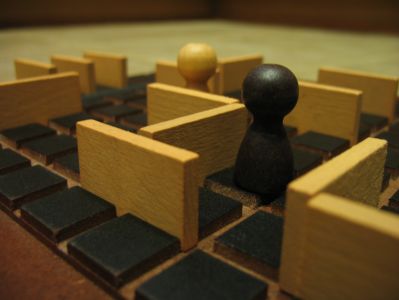
Game Essentials: Quoridor is a fantastic game of strategy, especially for those who like mazes. In the typical two-player setup, the pawns are placed on the middle squares of opposite sides of a 9×9 board. The winner is the first to maneuver her pawn from its starting position to any of the nine squares on her opponent’s side. Generally speaking, you can move one square at a time, forward or backward or left or right but usually not diagonally. You can also jump over your opponent’s pawn when the two pawns are face to face. Seems trivial so far, right? That’s because we haven’t yet discussed the fences! You see, at each turn, a player can choose to either move her pawn or to impede her opponent by putting up a fence that blocks or lengthens the opponent’s path. Twenty fences are divided evenly at the start of the game, and the main rule governing them is that you can’t use them to block all possible paths – there must be at least one way to get from one side of the board to the other. The video below from Gigamic illustrates these rules:
For brevity’s sake, the video showed a short and simple game. But, in fact, games are typically much more complex. With each fence placed on the board, an increasingly complicated maze of paths from one side to the other is built. And the results can be downright maddening! One minute, you think you’re making good progress only to have your pathway dead-ended by your opponent, in which case you have to backtrack, costing precious moves. Another time, you may turn the tables on your opponent by blocking him only to be obstructed by your own fence placement later in the game.
As with most abstract strategy games, winning depends on your ability to think ahead about the possible outcomes of available moves and select the optimal path. In other words, to take your strategy beyond simply “move forward – block opponent,” you must build and analyze a decision tree in your mind. You also need to think offensively and defensively at all times. For example, if you are progressing alongside a series of fences, your opponent will almost certainly use a new fence to block you just as you get to an opening. However, if you use one of your fences to block the path behind your pawn, then your opponent may not be allowed to block your way forward if it would close off all paths. Still, you must be careful to use your fences judiciously so that you don’t run out of them too soon.
Quoridor may also be played with three or four players. Each player selects one of the four sides of the board as the side for his pawn’s starting position and works toward being the first to reach the opposite side. Divide the fences up so that each player has an equal number with as few left over as possible. Then just follow the rules of movement and fence placement from the two-player game.
Recommended Age: The manufacturer suggests ages 6 and up, and we tend to agree. The rules of play are simple, but it does take a certain level of maturity to keep from getting frustrated when your opponent repeatedly blocks off your path.
Brain Play-To-Price Ratio: Quoridor lists for $29.99 but can be found for around $23. The rules and objective are easy for the youngest or most inexperienced players to learn, but mastering the game is a fun challenge that will engage children and adults alike for many years. As with most Gigamic board games, Quoridor is made of sturdy wood. And under Gigamic’s 10-year warranty, all you have to do to get free (love it!) replacement game pieces is send a letter to Gigamic.
Easier Adaptation: Gigamic makes a version called Quoridor Kid for ages 5 and up that costs about $5 less. The board is 7×7 instead of 9×9, and there are 16 fences instead of 20. The neutral-color game pieces and board are replaced by cute little mice, colorful fences and a cheerful board. Each mouse has a different colored nose which matches one of four colored cheese wedges on each side of the board. This nose-to-cheese match helps keep little ones focused on exactly which side of the game board they are aiming to reach. The smaller board typically means that a game of Quoridor Kid lasts a shorter amount of time. But the game rules are the same as Quoridor, and thus encourage the same kind of strategic thinking, albeit with a smaller number of paths to consider. The choice between starting with Quoridor Kid or going straight to Quoridor depends on whether you think your child would be more willing to stay engaged with the game due to the cute mouse-and-cheese theme. After all, you could just use the inner 7×7 section of “grown-up” board by ignoring the edge squares, as well as four of the fences.
Noteworthy: You can sample Quoridor online before deciding on a purchase. Just know that manipulating the fences online is not nearly as natural as when you’re holding the real thing in your hand.
Quarto by Gigamic
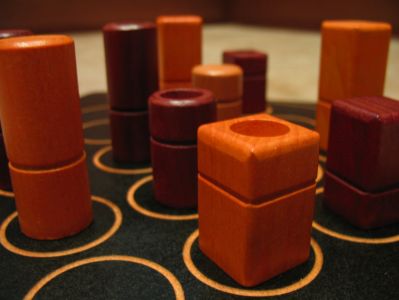
Game Essentials: Quarto is a two-player game that comes with 16 solid wood pieces and a sturdy 4×4 wooden board. All pieces not yet placed on the board are available to each player. The object of the game is simple: Be the first player to get four pieces that share a common feature in a line and call out “Quarto!” The line can be horizontal, vertical or diagonal, and you do not have to have placed all four pieces on the board yourself. So what are the possible common features? There are eight: a game piece can be light or dark, circular or square, short or tall, and hollow or solid. (A little elementary combinatorics confirms that we should, indeed, have 16 unique game pieces.) Here’s the kicker that makes Quarto stand out from other N-in-a-row games – you don’t pick the pieces that you place on the board; your opponent does! The following video illustrates these rules:
Quarto hones the mind’s ability to recognize patterns. This simple twist of picking out your opponent’s pieces comes with great responsibility for you must take care not to literally hand him the win. If you see that there is already a line with three circular pieces, then choose a square piece for him. If you’ve set yourself up to win with a short piece, then you might try to force your opponent to hand you one by giving him all the remaining tall pieces to play, assuming that such a move doesn’t give him the win.
As with games like tic-tac-toe or Connect Four, a primary strategy with Quarto is to set up more than one possible way to win so that if your opponent blocks one, you can still try to win with another. The ultimate two-pronged approach is to build two lines around two opposing features, e.g., one line of light pieces and another line of dark pieces. Then no matter what piece your opponent hands you next, you’re guaranteed a win because the piece you get, in this example, has to be either light or dark.
Recommended Age: The manufacturer suggests ages 6 and up, but a bright kindergartener should be able to enjoy this game. The rules are very simple. The only thing that takes getting used to is having your opponent choose the pieces that you place on the board instead of selecting them yourself.
Brain Play-To-Price Ratio: Like Quoridor, Quarto lists for $29.99 but can be found for around $23. If you want to experience either game for less, look for the travel editions. The craftsmanship is still excellent, but the smaller size will save you at least another $5. Quarto is fun for all ages, and Gigamic’s 10-year warranty and generous replacement policy applies to it as well.
Multipurpose: For small children, the wood pieces make for obvious fun as building and balancing blocks to hone fine motor skills. But you can also use them to introduce Venn diagrams. Just draw two large overlapping circles on a piece of paper and decide what characteristic each circle represents. For example, one circle can be tall pieces and the other circle can be hollow pieces. Ask your child to place each of the 16 pieces in the appropriate area of the paper. Change up what the circles represent and do it again. Add a new characteristic and expand to three overlapping circles. Not enough room on a sheet of paper? Get some yarn or raid the belts in Dad’s closet and make overlapping loops instead.
Easier Adaptation: With younger or less experienced players, you can simplify the objective by using just one, two or three of the four characteristics to make a winning line. For example, the first person to get four of the same color or four of the same shape in a line wins. Forget about height and hollowness until players feel ready to add on another level of difficulty.
Noteworthy: The Quarto rules also suggest a variation for advanced players that allows for nine more winning configurations. Specifically, in addition to getting four pieces in a line, you can win by getting four in a square. Just try keeping your eyes on all those possibilities!
Othello by Mattel

Othello, also known as reversi, is a widely-played classic game of strategy that has been around in some form since the late 1800’s. Its trademarked slogan sums it up beautifully: “A minute to learn, a lifetime to master!”™ With its simple rules, Othello can be played by children as young as five, even though the recommended age is eight to adult. If you’ve never had the pleasure of playing this game, watch the video explanation below:
Othello is an ideal game for teaching one of the key elements of strategy games, which is to think longer-term even if it means not choosing a move that seems optimal in the short-term. If you approach each turn with the goal of maximizing the number of disks of your color at the end of that one turn, then you will surely lose. Experienced players focus, instead, on setting up “helper” positions that will lead to the capture of certain prized locations on the board. These coveted spots (e.g., corners and edges) give a player tremendous leverage during the last series of moves that take place toward the end of a game.
Given the age and popularity of Othello, it should come as no surprise that its game strategies have been extensively researched, analyzed and documented. Here is a fairly readable strategy guide from the French Othello Federation. You can appreciate from this and other Othello guides that pattern recognition, another key element of strategy games, is an essential skill for winning.
Othello lists for $11.99, and will provide many hours of game play for the whole family. It’s also commonly available as a smartphone or tablet app and online. If you’d like to see some of the best Othello players in the world compete, you are somewhat in luck because the 35th Annual World Othello Championship will be held in the US this year.
If you are just discovering this blog, check out Part One of the series on logic games and Part Two on visual-spatial games. We hope that, through this series, you have discovered a new game or two to keep your brain active during these summer months and for years to come.
Make the right move with IMACS. Sign up for our free aptitude test. Play along with our weekly IMACS logic puzzles on Facebook.
In Part Two of our summer series on thinking games, we focus on those that exercise the brain’s visual-spatial abilities. The three games we recommend below will have you shifting, flipping, and rotating objects in your mind and sharpening your problem solving skills.
Katamino by Gigamic
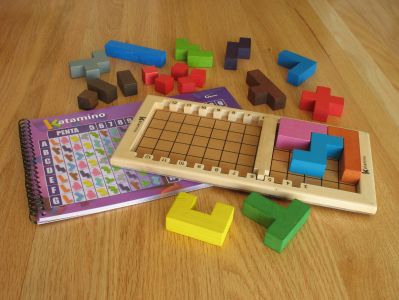
Game Essentials: Katamino is a versatile tiling game that will put your spatial reasoning abilities through a serious workout. The game comes with 12 three-dimensional pentominoes, eight smaller support pieces, a grid-based board, and a booklet full of challenges. A pentomino is simply a shape consisting of five congruent squares that are connected at their edges. In the case of Katamino, each of the 12 main pieces consists of five congruent cubes that are connected at their faces. Gigamic calls these “pentaminos.”
There are variations on how to play, but in the standard solitaire approach, the object is to neatly place a subset of the pentaminos in a rectangular section of the board. If your goal is to tile N pentaminos (a “Penta N”), then the section will be an Nx5 rectangle. A player typically starts with a Penta 3 challenge. Once it is solved, the player adds another pentamino to the mix and rearranges the now-larger set of four pieces to solve the Penta 4. Next is a Penta 5, a Penta 6, and so on. The puzzles get progressively harder as you add pentaminos.
Another neat way to play is to select one of the pentaminos and then use nine of the remaining 11 to create a larger version of the first one that you chose. This can be done for every pentamino. Challenge yourself to replicate all 12. There are 3-D challenges as well where a player uses the pentaminos and support pieces to build the three-dimensional objects pictured in the booklet. Mathematically speaking, the standard Katamino game is two-dimensional but played with three-dimensional pieces for practical purposes. We imagine that flat pentominoes that are hard to pick up would make the game incredibly frustrating to play, not to mention how fragile they would be in little hands.
Katamino may also be played as a two-player game. In the speed game, players evenly divide 10 of the 12 pentaminos (all except for the “I” and the “X”) and all of the support pieces. The opponents then race to see who can tile his or her half of the board first. The strategy game uses only the 12 pentaminos and an 8×8 board included in the booklet. Each player takes a turn placing a pentamino anywhere on the board. The last player to place a pentamino on the board wins.
Recommended Age: The manufacturer suggests ages 3 and up, and we couldn’t agree more. With its colorful wooden blocks, this is just the kind of game to captivate and stimulate young minds. Kids can’t help but be enticed by the colorful assortment of shapes that almost seem to call out, “Build something with me!” And with the eight smaller support pieces, even three-year olds can enjoy the challenge of tiling without any guidance.
Brain Play-To-Price Ratio: Katamino lists for $29.99 but can be found for around $22. There are 500 challenges included in the accompanying booklet, so children and adults of all ages will have no trouble finding puzzles with just the right level of difficulty. After solving the challenges that come with the game, see if you can enumerate additional challenges. This should keep you busy for a while as there are literally thousands more. This is a well-constructed game made of solid wood that will last through lots of rough and tumble play. And kudos to Gigamic for recognizing that a solid wood game, with its extra heft, needs a reinforced box for storage. When your child passes Katamino down to your grandchildren, it won’t be in a box that looks like something out of “The Mummy.”
Multipurpose: Katamino is a great game with which to introduce concepts from Euclidean geometry. Don’t be afraid to use mathematically precise terms such as “polygon” when playing with a child who has not studied the subject. Start by assuming that the pieces are comprised of unit cubes and explain what that means. Then show how to compute the perimeter and area of each face as well as the volume of each shape. Flip and turn the shapes to demonstrate the concept of symmetry. Which pieces have reflective symmetry, and what are the lines of symmetry? Which pieces have rotational symmetry, and what is the order of the rotation?
Another two-player variation is to play a game of balance by using the blocks to build a stack. Each player takes a turn placing one block on the stack. Whoever is last to place a piece on the increasingly unstable stack without causing it to topple is the winner. This is a great way to sneak in some basic principles of Newtonian physics.
Easier Adaptation: Gigamic makes an easier version called Winomino that includes six of the 12 pentaminos and ten additional pieces that are formed by one, two, three, or four cubes. The smaller pieces allow greater flexibility in solving the Penta challenges. The prices for Winomino and Katamino are about the same. If your child is older or is a natural visual-spatial thinker, then we suggest bypassing Winomino and going straight to Katamino.
Noteworthy: Pentominoes belong to a more generic class of shapes called polyominoes, so named to be consistent with the two-square shape of the well-known domino. Use four squares and you get a tetramino, which is the basis for the popular 80’s video game, Tetris. You can play Tetris online.
Shape By Shape by ThinkFun
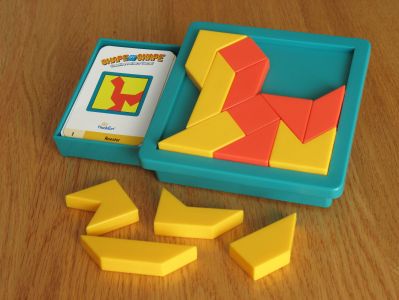
Game Essentials: In this variation on the traditional tangram puzzle, 14 puzzle pieces must be arranged in a square tray to match the pattern on one of 60 challenge cards. Six orange pieces form the foreground image, and eight yellow pieces form the background. The orange pieces consist of identical pairs of each of the following: square, parallelogram, and isosceles right triangle. The yellow pieces consist of identical pairs of each of the following: right trapezoid, isosceles trapezoid, swallowtail flag, and a five-sided polygon that resembles a boot. To solve a puzzle, a player must place all 14 pieces neatly inside the puzzle tray with no leftovers and no pieces sticking up.
Anyone can try to solve the puzzles by placing the pieces in a haphazard way without much thoughtful planning. In our observations this usually results in more frustration than solutions, and that’s no fun. The real visual-spatial brain exercise and enjoyment comes when you take the necessary time to really think about where each puzzle piece should go. And it’s these mental gymnastics that can improve a person’s ability to handle visually intensive tasks from planning the seating at a wedding reception to designing pharmaceutical drugs to guiding a space-walking astronaut through a complex and unexpected situation from down here on Earth.
While the Shape By Shape challenges are not ranked by level of difficulty, some are definitely easy and others much harder. Take a look at the dog and cat patterns below, and you’ll see what we mean.
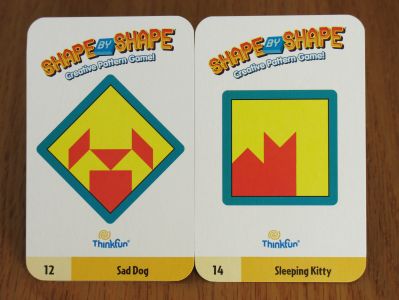
The Sad Dog in Challenge 12 is symmetric about the diagonal from top to bottom. Though not always the case, challenges with symmetric images often have solutions that require symmetric placement of the puzzle pieces. Furthermore, the pieces in the dog pattern do not share many edges, so it’s easier to recognize the shapes of individual pieces because they are not part of a larger area made up of connected pieces. For example, the eyes of the dog are obviously the two parallelograms while the nose is clearly one of the triangles. The two yellow areas that are shaped like the swallowtail flags pieces can only be made by those two pieces. Going outward from the eyes to the left and right corners, the yellow areas are most certainly the two “boots”. Once these obvious pieces are put in place, the placement of the other pieces becomes trivial.
By contrast, the Sleeping Kitty in Challenge 14 is asymmetric in every direction, and the pieces in the orange area share a lot of common edges that are in the interior of the cat shape. In kid-speak, the orange pieces are in one big blob. A more mathematical way of putting it would be that the ratio of the area of the cat to its perimeter is relatively high. The same observations can be made about the yellow area. Generally speaking, the higher this area-to-perimeter ratio, the harder the challenge because your visual-spatial brain function has to sort through more combinations of pieces in order to replicate the pattern.
Recommended Age: The manufacturer suggests ages 8 and up, but we think this is an ideal puzzle for much younger kids. Children who are not ready for the puzzle’s pre-defined parameters still stand to gain from the exploratory learning that just naturally happens through play. As a recent academic study indicated, Euclidean geometry is so intuitive that tribal children with no formal education in the subject understand its basic principles.
Brain Play-To-Price Ratio: Shape By Shape lists for $14.99 but can be found at a slight discount. Even at full price, we think this game is a great value. As with all the ThinkFun games we’ve played, Shape By Shape is made with high-quality plastic that’s built to last. The puzzles and the number of puzzle pieces are at just the right level to be challenging but not frustrating for players of all ages and abilities. Sixty puzzles will keep you busy for while, especially if you commit to not looking at the hints on the back of the challenge cards, and you can enjoy the same puzzles again after taking a break. But one of the many cool things about Shape By Shape is that you can challenge yourself to discover new patterns not included with the game. Freestyle play is the one time when starting off with totally random placement is justified. Just go with it and see where it takes you. If you manage to fit all the pieces in the tray, check your pattern against the challenge cards and see if you’ve found a new one. If you’re really ambitious, try articulating the mathematical limits of the shape combinations that would fit in the tray.
Multipurpose: Shape By Shape is another game that is perfect for exploring geometry. Try explaining geometric concepts when discussing observations like the following: The perimeters of the parallelogram and isosceles right triangle are equal, and the perimeters of the isosceles trapezoid, swallowtail flag, and “boot” are equal. The side of the square is equal in length to the shorter diagonal of the parallelogram. It’s also equal to the line segment perpendicular to the triangle’s hypotenuse that connects the right angle vertex and the hypotenuse. Which angles are acute, and which are obtuse? The orange pieces are of equal area, and the yellow pieces are of equal area that is 50% greater than the area of each orange piece. (Can you prove these statements about area rigorously? If not, at least convince yourself visually.) We could go on and on, but you get the point.
Easier Adaptation: A two-part solution is given on the back of each challenge card. If you are working with a younger player, use the first hint to place some or all of the orange pieces. Then go back to placing the yellow pieces without help from the second hint. Unless, of course, you both get stuck and need the second hint. But don’t give up too soon!
Noteworthy: Shape By Shape is one of six ThinkFun games invented by master puzzle designer Nob Yoshigahara. You can read about his work on ThinkFun games here.
Rubik’s Cube by Hasbro
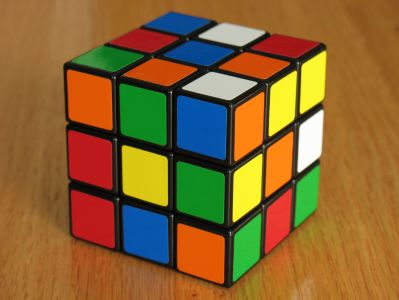
This iconic puzzle has been a part of international popular culture since 1980 when mass-distribution outside of Hungary, home of inventor Erno Rubik, began. We won’t spend much time describing it here. If you really haven’t heard of the Rubik’s Cube, you can explore the official Web site or the many online videos documenting the culture of speed cubing. Here’s one pulled from the oldie-but-goodie shelf. It’s a real throwback, especially for those who remember the 80’s TV show “That’s Incredible.”
Note that the first contestant introduced during the in-studio competition, Holden Thorp, is now the chancellor at UNC Chapel Hill after having earned his PhD in chemistry from Caltech and going on to receive the NSF’s Presidential Young Investigator Award among his many accomplishments.
Robots also enjoy the challenge of the Rubik’s Cube, or at least their human engineers do. You can watch and read about the robot that currently holds the speed record here.
For algebra aficionados, check out these two papers and a book relating group theory to the Rubik’s Cube:
• Group Theory and the Rubik’s Cube by Janet Chen
• Group Theory via Rubik’s Cube by Tom Davis
• Adventures in Group Theory: Rubik’s Cube, Merlin’s Machine, and Other Mathematical Toys by David Joyner
In our opinion, this little gem should be part of every child’s collection, although you should keep it away from little ones due to the small mechanical parts that can be removed. The original 3×3 Rubik’s Cube lists for $11.99 but can often be found for $8 or less. That’s dirt cheap these days for a cool thinking toy that’s also part of history. But if you’re just not into playing games in the physical world anymore, you can still test your Rubik’s solving skills here.
If you missed Part One on logic games, read it here. See you next week for Part Three on strategy games!
Visualize your future with IMACS. Take our free aptitude test. Follow IMACS on Facebook.
It’s the middle of July. Are your kids bouncing off the walls yet? Then it’s time to play a game! This post is the first in a three-part series on games we like to play at IMACS. Part One of the series will focus on logic games, while Parts Two and Three will cover visual-spatial games and strategy games, respectively. At IMACS we search for games that embody ideas that support successful learning: logical reasoning, focused thought, and fun! In addition, we try to recommend games that provide a good value for parents by being reasonably-priced, made with quality craftsmanship, and fun for all ages.
Chocolate Fix by ThinkFun
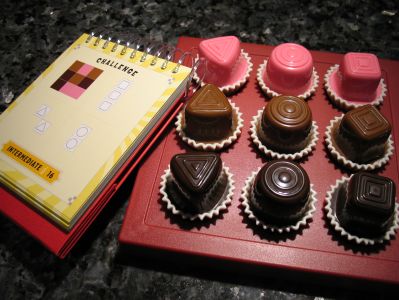
Game Essentials: Nine chocolate treats must be arranged in a 3×3 tray based on clues about their shape and color. Each chocolate is a circle, square, or triangle and exactly one of three colors. The current version of the game uses green, white, and brown, while the previous version used light brown, dark brown, and pink. Each puzzle has a set of clues that give incomplete information about the shape, color and relative location of some chocolates. Using the rules of mathematical logic, a single player determines the unique location on the tray of each of the nine chocolates. While Chocolate Fix is designed to be a solitaire game, parents and kids can play together by taking turns with the puzzles or with the clues of a single puzzle. If you like sudoku, then you’ll probably like Chocolate Fix.
Recommended Age: The manufacturer’s suggested age range is from 8 years old to adult, but we feel that talented kindergarteners and first-graders can handle the beginner-level challenges and possibly higher levels.
Brain Play-to-Price Ratio: The official list price for Chocolate Fix is $19.99, but it can commonly be found for about $15, which puts it in the range of a middle-of-the-road Barbie or Transformer. We think this is a bargain for a thinking game that, according to our IMACS students, is tons of fun. As with most ThinkFun games, Chocolate Fix comes with 40 challenging puzzles across four levels of difficulty. This allows the game to remain relevant as a player grows in age and skill. And unless you have a photographic memory, you can enjoy the same puzzles again and again after setting the game aside for a while. But the longevity of a game also depends on the quality of the craftsmanship. You might envision your child playing with it from age 5 to age 15, but will it hold up over a decade of use and abuse? Here we salute ThinkFun for manufacturing games with quality that appears to last. Plus they have a reasonable replacement policy; you can purchase up to five pieces with the first one costing $2.50 and each additional piece costing $0.50.
Multipurpose: With little ones, you can count the chocolates and use them to demonstrate the concepts of same and different. The realistic-looking treats also make for great pretend play. Use them to play Candy Store with your children and practice skills like addition and subtraction. Assign prices to the chocolates and then compute the total amount owed for each purchase and change due.
Easier Adaptation: ThinkFun also makes a similar game called Clever Castle aimed at 5-7 year olds. In this version, princesses, knights, and dragons that are either red, yellow, or blue have been invited to Clever Castle by the king and queen. A player uses clues to help the guests find their rooms. Clever Castle also comes with 40 puzzles across four levels of difficulty, but the higher levels in Clever Castle correspond to the lower levels in Chocolate Fix.
Noteworthy: The newest version of the Chocolate Fix includes shape and color placeholders to help a player remember one of the characteristics of a chocolate that belongs in a certain spot until the player can determine the other characteristic. To the extent that the placeholders help a beginner not give up too soon, we support their use. But once a player gets the hang of the game, we encourage setting the placeholders aside so that building up one’s memory and concentration skills can also be a benefit of playing the game.
Best of all, the Chocolate Fix game rules and challenges were developed by Mark Engelberg, alumnus of Project MEGSSS which was a predecessor program to IMACS! “There is no doubt,” says Engelberg, “that the MEGSSS/IMACS curriculum gave me the logical thinking skills and mental framework that inspired and enabled me to develop the Chocolate Fix puzzle system.”
ColorKu by Mad Cave Bird Games
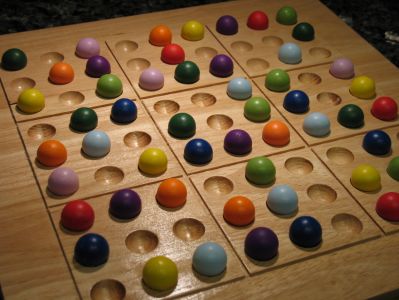
Game Essentials: We’re big fans of sudoku, and ColorKu is simply sudoku played with colors instead of numbers. The game comes with a 9×9 board and 81 colored wooden balls – nine colors and nine balls of each color. The fundamental rules are the same as number-based sudoku: From a given starting configuration, a player uses logical reasoning to determine the correct position on the grid of each of the remaining colored balls so that no row, no column, and no predefined 3×3 sub-square contains any duplicate colors. As with Chocolate Fix, this typically solitaire game can be played cooperatively among two or more players.
Recommended Age: The manufacturer’s suggested age range is from 8 years old to adult. Talented students of a younger age can handle this puzzle, but as the product warning suggests, children aged three and under should be kept away from this game due to the choking hazard presented by the little colored balls.
Brain Play-to-Price Ratio: The official ColorKu Web site lists the game for $32.99, but you can find it at a slightly discounted price of $30. This is by no means cheap, but for the solid wood craftsmanship of both the board and colored balls, this is a reasonable price that puts it in the range of Nintendo DS games. ColorKu comes with 104 puzzles across five levels of difficulty so that players of different skill levels can play. You can purchase an expansion pack with 104 new puzzles for about $10. Better yet, use the included number-to-color mapping to expand your puzzle set for free by converting any number-based sudoku game that you get from a newspaper, on the Web, or from a smartphone app. If you lose some of the colored balls, replacements start at $4.25 for a set of two of every color and go up to $11.75 for a complete set of 81. Shipping and handling to US addresses runs from about $3.25 to $5.95.
Multipurpose: What else can you do with 81 colorful balls and a grid? Your imagination is the limit. How about counting, bar charts, simple addition, subtraction, multiplication, and division. Play regular tic-tac-toe in one of the 3×3 squares. Improvise a game of Chinese checkers where each player must move his or her nine pieces from one of the outer 3×3 squares to the square on the opposite side of the board. Play marbles. Pretend to run a restaurant and serve “fruit salad” or “vegetable soup.” Challenge your child to name fruits and veggies of each color. If you run out of ideas, we’re certain your kids won’t.
Easier Adaptation: Parents can give younger players a boost simply by filling in some of the empty spots in the starting position of a puzzle with the appropriate balls based on the solution provided. As a player improves, reduce the number of additional clues.
Noteworthy: Mad Cave Bird Games sells sets of 81 balls with just two colors for playing their adaptation of tic-tac-toe. This will set you back another $20, which, if compared to buying unfinished wood balls and painting them yourself, is actually a fair price. However, we recommend that you first look around the house for objects such as small LEGO bricks that are colorful, numerous, and can be used just as effectively to play the tic-tac-toe adaptation.
Mastermind by Pressman Toys
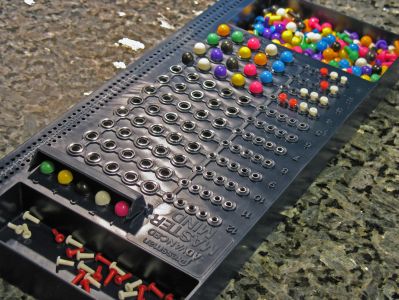
Game Essentials: In this classic two-player game, the code-maker starts by creating a secret code using four pegs that can be any combination of six colors. The code-breaker then takes a series of guesses at the code sequence. With each guess, the code-maker gives the code-breaker feedback on (i) the number of pegs that are the correct color but not in the correct position and (ii) the number of pegs that are the correct color and also in the correct position. Note that under the standard rules, the code-maker does not provide any information as to which pegs in the code-breaker’s guess are either a correct color or a correct color and position. The code-breaker uses logic and reasoning with each new piece of information from the code-maker to improve upon the prior guesses with each successive guess.
Recommended Age: The stated age range is from 8 years old to adult, but again, we think that bright, young kids can handle the challenge. Just be sure to heed the manufacturer’s warning and keep the tiny pegs away from children three and under.
Brain Play-to-Price Ratio: The standard version of Mastermind lists for $15 on the Pressman Toys site but sells for around $13, which, in our opinion, is a tad high for what you get. The quality of the manufacturing seems to have dropped off since Mastermind was introduced in the 70’s, but we recommend it nonetheless because the game itself remains consistently fun and stimulating for talented minds of all ages. There’s a reason it’s been around for 40 years – it really is an excellent thinking game. Just don’t expect to be impressed by its looks or for the cheap plastic and flimsy box to hold up over time. An entire set of replacement pegs costs only about $5 including shipping and handling, which should tell you something.
Multipurpose: Unfortunately, the quality of the pegs leaves us uninspired as to other uses.
Easier Adaptation: Pressman Toys offers an easier version called Mastermind for Kids, but the differences amount to reducing the code length to three colors and replacing the simple pegs with cutesy animal-shaped pegs. We think it’s more cost-effective to just purchase the standard version and reduce the code length yourself. That way, when your kids outgrow the challenge of three-color codes, they can move up to four-color codes and still use the same game board. For another simplifying trick, reduce the set of colors from which the code-breaker chooses to just one more than the number of pegs in the code. While the standard rules allow the code-maker to include pegs of the same color in the code, this can easily lead to confusion. Creating codes with all different colors eliminates this difficulty without making the game less fun. Finally, you can modify the rules so that feedback on the accuracy of peg color and location is peg-specific. This last suggestion works best with the advanced version of the game described below. In that version, the feedback indicators and the code pegs are both arranged in straight lines of five making it easy to match them up, whereas in the standard version, one is arranged in a square while the other is in a line.
Noteworthy: There is a more advanced version called … I’ll give you three guesses and the first two don’t count. If you said Advanced Mastermind, give yourself a pat on the back. This one uses a code length of five chosen from eight colors and costs about $20. If you think that Mastermind is a game that your family will enjoy through the ages, then it may be worth it to purchase Advanced Mastermind from the get-go and just keep working your way up to the maximum level of difficulty. And no, the higher price does not come with better manufacturing quality. Sorry! (That’s a fun game too, but not one for this blog.)
Well, boys and girls, that’s all for this week. If you have a favorite logic game that didn’t make our list, please tell us about it. Then go play!
Take your logical reasoning skills to the next level with IMACS. Sign up for our free aptitude test. Enter our weekly IMACS logic puzzle contest on Facebook.

IMACS’ Director of Curriculum Development, Dr. Ted Sweet, discusses the importance of challenging the gifted and talented student in order to reach his or her full potential and to avoid common pitfalls. Ted is a graduate of Project MEGSSS, a predecessor program to IMACS. He completed his undergraduate studies at the University of Miami and his Ph.D. in mathematics at UCLA. Ted joined IMACS in 1998.
Burt Kaufman, one of the foremost American mathematics curriculum developers of the last half-century (and my high school mentor), once made an observation that resonates with many educators of bright and talented children. It was that good grades obtained through little or no effort ultimately led to poor study habits and general intellectual laziness.
Even parents of children enrolled in “gifted” programs of the type currently in favor with many public school systems sometimes complain that their child is “coasting” at school.
Unfortunately, students that solve every problem with ease often get out of the habit of focusing and thinking systematically, skills they will need if they are to reach their full potential. Not surprisingly, it can be a challenge for parents to explain to their bright children that getting an ‘A’ may not be enough to ensure their future academic success.
Bright students whose mental agility and intuitive cognitive abilities are not sufficiently challenged can start to develop problems during elementary school. These may manifest themselves in the form of so-called “careless errors” when doing arithmetical problems, for example. And talented students who have not been stretched intellectually will typically “give up too easily” when they finally encounter challenging problems that require careful analysis. In extreme cases, behavioral problems may start to develop.
The question of how to satisfy the intellectual needs of bright and talented children has been studied in depth by the professionals at IMACS. Our research demonstrates that bright students who are exposed to curricula that foster the careful, logical analysis of significant math problems benefit in many fields outside mathematics. A student who learns to truly think does not leave that skill in the classroom.
What classes that you coasted through do you wish had been more challenging for you?
Challenge yourself to be your best with IMACS. Take our free aptitude test. Follow IMACS on Facebook.







